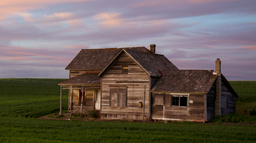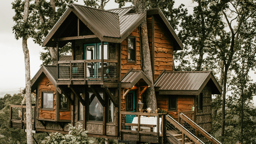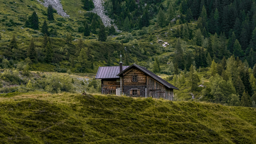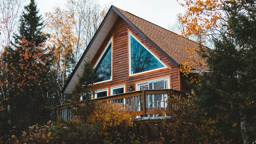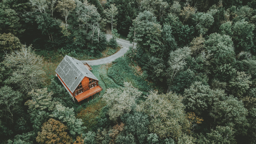
Wooden cabins are stronger than the average home, lasting 50+ years without much issue. However, despite their longevity, you must keep up with many maintenance requirements. Responsible owners should master these exterior and interior tips to protect and care for their cabins.
Caring for Your Cabin’s Exterior
Almost all of your cabin’s exterior is made of wood. Wood is a sturdy and reliable building material, especially rot-resistant species like pine, cypress and cedar. However, some key vulnerabilities must be addressed. Here’s how you can keep your cabin’s wooden exterior in good shape.
Protect the Wooden Siding
Rotting and cracking wood is the most common exterior issue with cabins. It faces constant exposure to the elements and absorbs moisture. If left untreated, it will slowly begin to split open and fall apart. The most important thing to do is restain the wood every five years or sooner, depending on its condition. Any exposed wood needs a protective finish.
You must also watch the roof’s shingles and gutters to ensure they drain properly. Efficient drainage will minimize moisture exposure and keep the wood as dry as possible. Roofing has unique seasonal requirements compared to other parts of the house. Focus on the gutters after the leaves drop during the fall and replace any damaged shingles in summer.
Discoloration, cracks, shrinkage and splintering mean your cabin has rotting wood. Wood showing these signs of damage must be replaced immediately. Poor condition can lead to foundational problems and compromise your cabin’s infrastructure.
Examine Your Lawn’s Drainage
You also must examine your lawn’s drainage to prevent foundation issues. Cracked and warped foundations are often the result of hydrostatic pressure. Soil that absorbs too much water will put more pressure on the foundation, seep into the porous materials and severely weaken the building’s overall structure.
Foundational issues caused by improper drainage are more common with cabins because they tend to be standalone structures with big lawns. Most other houses are in dense neighborhoods, so hydrostatic pressure is rarely an issue. Your home is even more vulnerable if a creek or stream runs through the property.
Rain gardens and extended downspouts are simple methods to ensure proper lawn drainage. You can plant a small garden in a low-lying spot to soak up excess water or add more piping to the downspouts to carry rainwater farther away. If you need to take drastic measures, installing more underground drainage pipes is the easiest solution.
Keep Critters Out
One of the weak points of log cabins is their susceptibility to pest infestations. Animals love making themselves at home inside wooden structures — especially bugs, birds and rodents. You need to block all possible entry points to prevent unwelcome guests. If you see any chewed items or smell foul odors, it’s probably too late.
Start by plugging up any small cracks and crevices around the roof, windows and doors. Caulk, urethane and expandable foam are three effective products that won’t damage the wooden siding. You also need to be careful about your outdoor activities. Animals are bound to appear if you leave food and drinks lying around.
Soak up the Sun
The sun is one of your cabin’s worst enemies. Ultraviolet rays slowly eat away at the wooden exterior over time, burning through the stain finishes and exposing the entire structure. That’s why you also need to add a spar varnish finish along with the other staining solutions. Spar varnish improves the wood’s UV-ray resistance and makes it more flexible, helping it stretch and contract better in response to weather changes.
Caring for Your Cabin’s Interior
Interior maintenance heavily depends on the home’s design. Walls and floors tend to be the most problematic areas in log cabins. Wood naturally absorbs moisture over time, so these areas are prone to warping and sagging. Here’s how to address these problems and other common cabin interior issues.
Take Special Care of the Flooring
Hardwood floors are prone to sagging because they don’t handle moisture well. You can reinforce the floor joistswith additional blocking or metal bridging, but the best solution is to focus on climate control. You must keep indoor humidity levels down and maintain a consistent temperature, especially during the winter when you spend more time inside.
Keeping the floors clean also goes a long way. Generally, you should never use wet mops to clean hardwood floors. Instead, use a dry microfiber mop to prevent streaks and unnecessary moisture exposure. Sweeping the floors daily is another good habit to start. Floor maintenance is all about preserving a consistent indoor environment.
Fight Against Wall Damage
A similar principle applies to your cabin’s wall maintenance. High moisture levels, poor ventilation, and extreme temperature fluctuations can cause them to warp and develop nasty mold and mildew. External factors like roof leaks can also lead to wall damage. How can you fight all these issues at once?
You must reseal your cabin’s exterior to prevent moisture from getting inside. You should also establish strong and consistent airflow to keep the indoor moisture levels down at all costs. Open the windows and use fans to keep air moving and prevent moisture from sticking to the walls.
Filter Your Water Supply
Most cabins use groundwater from a nearby well instead of local tap water. You might have noticed it has a distinct taste and texture. That’s because groundwater has more minerals than tap water, which gives it more of a metallic flavor and helps it stay clean.
However, groundwater’s various minerals can build up in your cabin’s piping, causing plumbing issues and damaging fixtures. Prevent this problem by using a water softener or quality filtration system to remove excess minerals and keep your plumbing in good condition.
Protect Your Cabin Inside and Out
Cabins are built to last for generations. You must practice these maintenance habits if you want your kids and grandkids to enjoy everything your house has to offer. Do something to protect your cabin inside and out every day, whether checking for pests, sweeping the floors or improving the landscaping. Don’t take any days off when it comes to upkeep.




